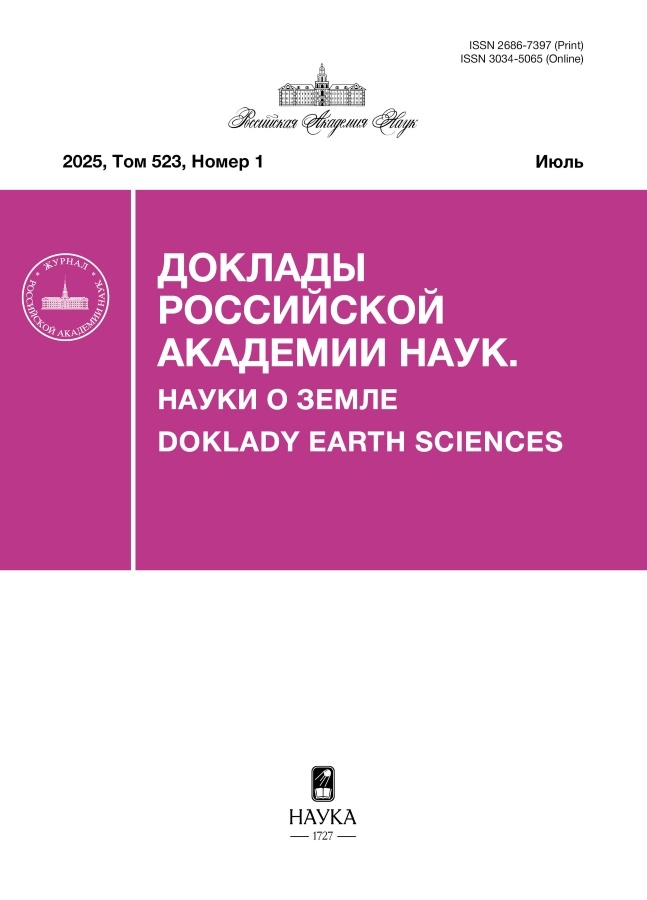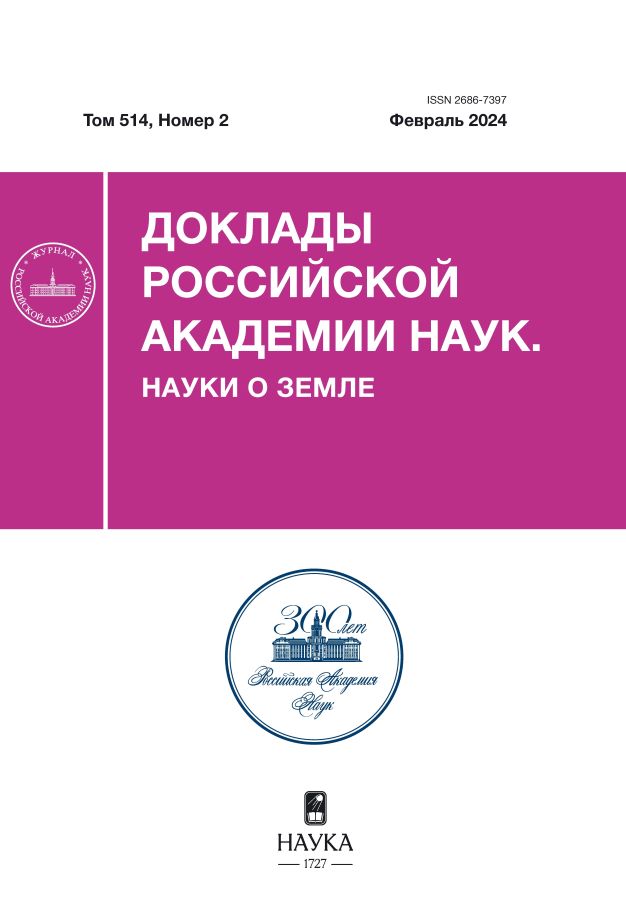Yochelcionella chinensis (Gastropoda: Helcionelliformes) из нижнего кембрия Западной Монголии
- Авторы: Пархаев П.Ю.1, Жегалло Е.А.1, Доржнамжаа Д.2
-
Учреждения:
- Палеонтологический институт им. А. А. Борисяка Российской академии наук
- Институт палеонтологии Монгольской академии нау
- Выпуск: Том 514, № 2 (2024)
- Страницы: 300-307
- Раздел: ПАЛЕОНТОЛОГИЯ
- Статья получена: 31.01.2025
- Статья опубликована: 12.09.2024
- URL: https://edgccjournal.org/2686-7397/article/view/650090
- DOI: https://doi.org/10.31857/S2686739724020139
- ID: 650090
Цитировать
Полный текст
Аннотация
В ходе ревизии малакофауны из венд-нижнекембрийских отложений Западной Монголии переизучены материалы по роду Yochelcionella Runnegar et Pojeta, 1974 из саланыгольской и хаирханской свит Дзабханской структурно-фациальной зоны. Установлено, что в данных толщах помимо отмеченных ранее видов Y. parva Zhegallo, 1996 и Y. crassa Zhegallo, 1996 присутствуют еще две формы, определенные как Y. chinensis Pei, 1985 и Yochelcionella sp. Y. chinensis имеет самое широкое распространение среди видов Yochelcionella и может с успехом использоваться для корреляции отложений удаленных палеобассейнов. Ревизованы диагноз и состав рода Yochelcionella, приводится описание вида Y. chinensis с дополненной синонимикой и уточненным распространением.
Ключевые слова
Полный текст
Об авторах
П. Ю. Пархаев
Палеонтологический институт им. А. А. Борисяка Российской академии наук
Автор, ответственный за переписку.
Email: pparkh@paleo.ru
Россия, Москва
Е. А. Жегалло
Палеонтологический институт им. А. А. Борисяка Российской академии наук
Email: pparkh@paleo.ru
Россия, Москва
Д. Доржнамжаа
Институт палеонтологии Монгольской академии нау
Email: pparkh@paleo.ru
Монголия, Улан-Бато
Список литературы
- Parkhaev P. Yu. Chapter 3: The Early Cambrian Radiation of Mollusca. Phylogeny and Evolution of the Mollusca / Ponder W. F., Lindberg D. R. (eds.). Berkeley: University of California Press, 2008. P. 33–69.
- Пархаев П. Ю. Малакофауна быстринской свиты Восточного Забайкалья // Палеонтологический журнал. 2004. № 6. С. 9–25.
- Пархаев П. Ю. Кембрийские моллюски Австралии: обзор таксономии, биостратиграфии и палеобиогеографии // Стратиграфия. Геологическая корреляция. 2019. Т. 27. № 2. С. 52–79.
- Runnegar B., Pojeta J. Molluscan phylogeny: the paleontological viewpoint // Science. 1974. V. 186. P. 311–317.
- Kouchinsky A., Bengtson S., Clausen S., Vendrasco M. An early Cambrian fauna of skeletal fossils from the Emyaksin Formation, northern Siberia // Acta Palaeontologica Polonica. 2015. V. 60. № 2. P. 421–512.
- Жегалло Е. А. Класс Gastropoda. Ярусное расчленение нижнего кембрия. Атлас окаменелостей. Ред. Соколов Б. С., Журавлева И. Т. М.: Наука, 1983. С. 96–100.
- Geyer G. Mittelkambrische Mollusken aus Marokko und Spanien // Shenckenbergiana lethaea. 1986. V. 67. P. 55–118.
- Федоров А. Б. Новые трубчатые проблематики из стратотипа томмотского яруса // Палеонтологический журнал. 1986. № 3. С. 110–112.
- Hinz I. The Lower Cambrian microfauna of Comley and Rushton, Shropshire, England // Palaeontographica Abteilung A. 1987. Bd 198. P. 41–100.
- Pei F. First discovery of Yochelcionella from the Lower Cambrian of China and its significance // Acta Micropaleontologica Sinica. 1985. V. 2. № 4. P. 395–400.
- Bengtson S., Conway Morris S., Cooper B. J., Jell P. A., Runnegar B. N. Early Cambrian fossils from South Australia // Association of Australasian Palaeontologists Memoirs. 1990. V. 9. P. 1–364.
- Atkins Ch.J., Peel J. S. Yochelcionella (Mollusca, Helcionelloida) from the lower Cambrian of North America // Bulletin of Geosciences. 2008. V. 83. № 1. P. 23–38.
- Skovsted C. B., Peel J. S. Early Cambrian brachiopods and other shelly fossils from the basal Kinzers formation of Pennsylvania // Journal of Paleontology. 2010. V. 84. № 4. P. 754–762.
- Пегель Т. В., Егорова Л. И., Коровников И. В., Лучинина В. А., Салихова А. К., Сундуков В. М., Федоров А. Б., Журавлев А. Ю., Пархаев П. Ю., Демиденко Ю. Е. Стратиграфия нефтегазоносных бассейнов Сибири (в девяти книгах). Кембрий Сибирской платформы. Том 2. Новосибирск: ИНГГ СО РАН, 2016. 311 с.
- Yun H., Zhang X., Li L., Zhang M., Liu W. Skeletal fossils and microfacies analysis of the lowermost Cambrian in the southwestern margin of the North China Platform // Journal of Asian Earth Sciences. 2016. V. 129. P. 54–66.
- Li L., Zhang X., Skovsted Ch.B., Yun H., Pan B., Li G. Revisiting the molluscan fauna from the Cambrian (Series 2, Stages 3–4) Xinji formation of North China // Papers in Palaeontology. 2019. P. 1–44.
- Skovsted C. B., Peel J. S. Small shelly fossils from the argillaceous facies of the Lower Cambrian Forteau Formation of western Newfoundland // Acta Palaeontologica Polonica. 2007. V. 52. № 4. P. 729–748.
- Есакова Н. В., Жегалло Е. А. Фауна и биостратиграфия нижнего кембрия Монголии. М.: Наука, 1996. 216 с. (Тр. Совм. Рос.-Монгол. палеонтол. экспед. Вып. 46).
- Bassett-But L. The Cambrian lophotrochozoans of the Transantarctic Mountains, Antarctica. Philis. licent. thes. Uppsala Univ. 2015. 21 p. (manus.).
- Claybourn T. M., Jacquet S. M., Skovsted Ch.B., Topper T. P., Holner L. E., Brock G. A. Mollusks from the upper Shackleton Limestone (Cambrian Series 2), Central Transantarctic Mountains, East Antarctica // Journal of Paleontology. 2019. V. 93. № 3. P. 437–459.
Дополнительные файлы














